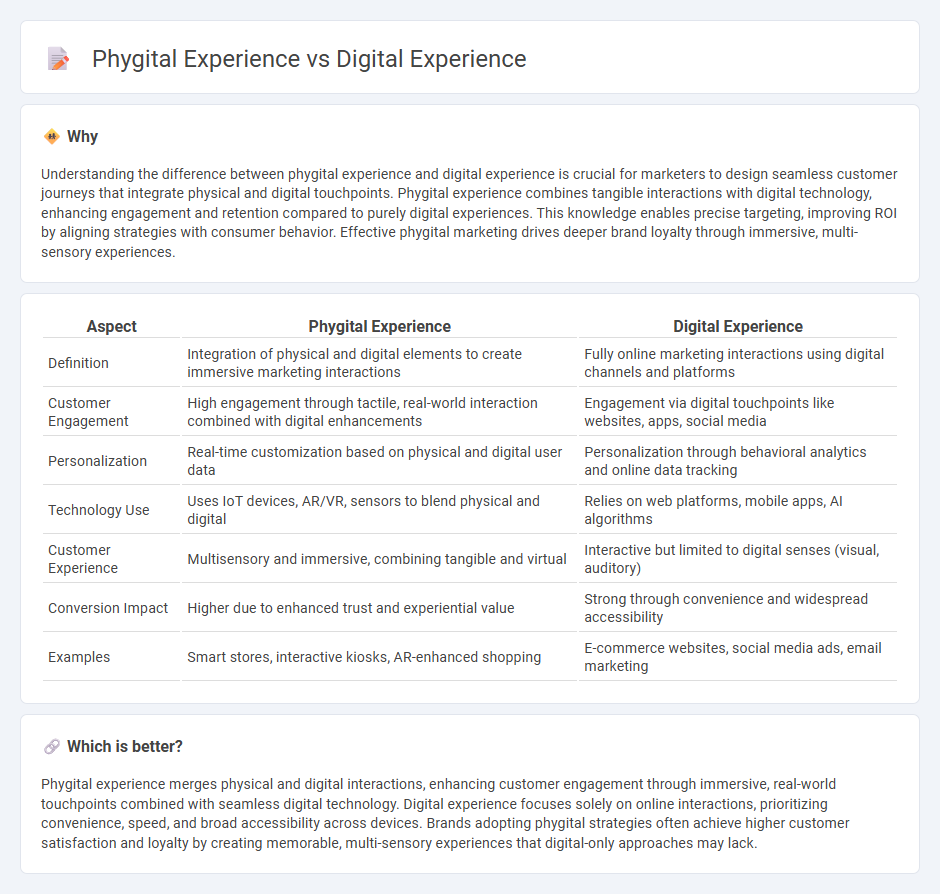
Phygital experiences blend physical and digital elements to create immersive customer interactions, enhancing brand engagement beyond traditional digital-only channels. This approach leverages in-store technology, augmented reality, and interactive displays to deliver personalized and seamless user journeys. Discover how integrating phygital strategies can transform your marketing efforts and amplify customer loyalty.
Why it is important
Understanding the difference between phygital experience and digital experience is crucial for marketers to design seamless customer journeys that integrate physical and digital touchpoints. Phygital experience combines tangible interactions with digital technology, enhancing engagement and retention compared to purely digital experiences. This knowledge enables precise targeting, improving ROI by aligning strategies with consumer behavior. Effective phygital marketing drives deeper brand loyalty through immersive, multi-sensory experiences.
Comparison Table
| Aspect | Phygital Experience | Digital Experience |
|---|---|---|
| Definition | Integration of physical and digital elements to create immersive marketing interactions | Fully online marketing interactions using digital channels and platforms |
| Customer Engagement | High engagement through tactile, real-world interaction combined with digital enhancements | Engagement via digital touchpoints like websites, apps, social media |
| Personalization | Real-time customization based on physical and digital user data | Personalization through behavioral analytics and online data tracking |
| Technology Use | Uses IoT devices, AR/VR, sensors to blend physical and digital | Relies on web platforms, mobile apps, AI algorithms |
| Customer Experience | Multisensory and immersive, combining tangible and virtual | Interactive but limited to digital senses (visual, auditory) |
| Conversion Impact | Higher due to enhanced trust and experiential value | Strong through convenience and widespread accessibility |
| Examples | Smart stores, interactive kiosks, AR-enhanced shopping | E-commerce websites, social media ads, email marketing |
Which is better?
Phygital experience merges physical and digital interactions, enhancing customer engagement through immersive, real-world touchpoints combined with seamless digital technology. Digital experience focuses solely on online interactions, prioritizing convenience, speed, and broad accessibility across devices. Brands adopting phygital strategies often achieve higher customer satisfaction and loyalty by creating memorable, multi-sensory experiences that digital-only approaches may lack.
Connection
Phygital experience combines physical interaction with digital technology to create seamless customer journeys that enhance engagement and satisfaction. Digital experience facilitates real-time data collection and personalized content, which fuels tailored phygital touchpoints. Both experiences rely on integrated platforms to synchronize online and offline consumer behaviors, driving effective marketing strategies and increased conversion rates.
Key Terms
Omnichannel
Digital experience leverages online platforms, mobile apps, and virtual interfaces to create seamless customer interactions across multiple digital touchpoints. Phygital experience combines physical retail spaces with digital technologies such as augmented reality, beacons, and interactive kiosks to enhance in-store engagement, creating a unified omnichannel strategy. Explore how integrating digital and phygital experiences can optimize customer journeys and boost brand loyalty in a connected marketplace.
User Journey
Digital experience streamlines the User Journey through online interfaces, enabling quick access, personalization, and real-time interactions with seamless navigation across devices. Phygital experience combines physical touchpoints with digital technologies, enriching the User Journey by blending sensory engagement and contextual relevance in both online and offline environments. Explore how integrating these approaches can optimize user satisfaction and business outcomes.
Touchpoints
Digital experience centers on virtual touchpoints such as websites, apps, and social media, offering seamless online interactions through personalized content and real-time feedback mechanisms. Phygital experience integrates physical touchpoints like in-store displays and interactive kiosks with digital elements, creating immersive, multi-sensory engagement that bridges the gap between offline and online worlds. Explore how optimizing touchpoints in both digital and phygital realms can elevate customer engagement and brand loyalty.
Source and External Links
What Is Digital Experience? | IBM - Digital experience refers to user interactions with organizations through digital technologies across many touchpoints like websites, mobile apps, and AI, aiming to create cohesive, contextual customer journeys that improve satisfaction and loyalty.
What is digital experience? - Dynatrace - A digital experience is a user's interaction with digital touchpoints such as apps or websites, shaped by factors like availability, performance, usability, and error-free operation, which organizations monitor to enhance user satisfaction and competitive advantage.
What is digital customer experience? A comprehensive guide - Digital customer experience is how customers perceive a brand through every digital interaction, requiring seamless, personalized, and frictionless touchpoints across platforms like websites, mobile apps, chatbots, and social media to meet high user expectations and drive loyalty.
 dowidth.com
dowidth.com